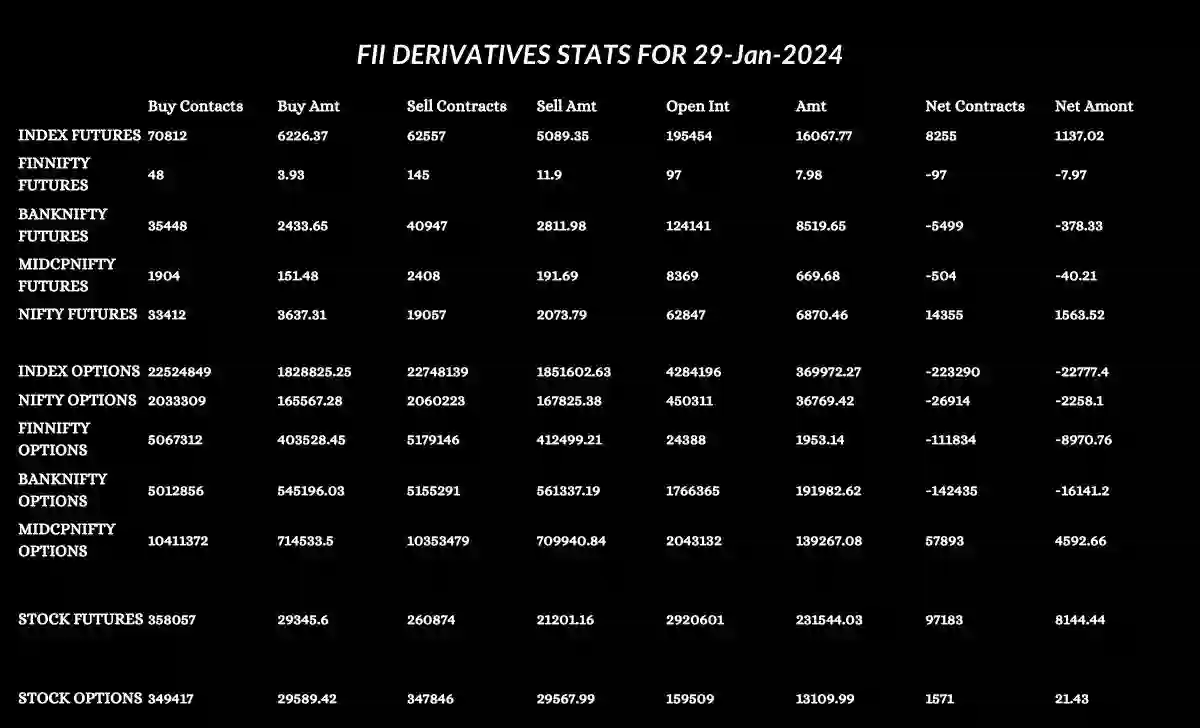Bulls Charge Ahead on 31 January 2024 with Robust FII DII Data Amidst Anticipation for Interim Union Budget on 1st February: NSE Share Bazaar Update
As the NSE Share Bazaar experienced a dynamic day on 31 January 2024, investors and traders eagerly anticipate the Interim Union Budget scheduled for 1st February 2024. Against this backdrop, indices showcased a roller-coaster ride, with NIFTY and BANKNIFTY playing pivotal roles. Let’s delve into the key data points and trends that shaped the day’s trading, all while keeping an eye on the forthcoming budgetary developments.
NIFTY Index Movements: Bulls Regain Control
The NSE NIFTY kicked off the day at 21,487.25, slightly lower than the previous day’s close at 21,522.10. Initial weakness saw NIFTY touch a low of 21,448.85 before staging a robust recovery. Bulls took charge, propelling the index to a high of 21,741.35. Closing near the day’s peak at 21,725.70, NIFTY recorded a notable gain of 0.95%.
Comparing the top gainers and losers in the NIFTY index, pharmaceutical giant DRREDDY, automotive leader EICHERMOT, and healthcare stalwart SUNPHARMA emerged as the winners. On the flip side, engineering major LT, jewelry and watch titan TITAN, and energy heavyweight BPCL faced setbacks.
BANKNIFTY Resilience: Financial Stocks Lead Recovery
BANKNIFTY opened weak at 45,295.65 but swiftly rebounded from a low of 45,071.20. Led by financial stocks, the index marked a high of 46,179.75, closing the day at 45,996.80 with a notable gain of 1.39%. The banking sector’s resilience underscored the market’s bullish sentiment.
Top gainers in the BANKNIFTY index included Punjab National Bank (PNB), Bank of Baroda (BANKBARODA), and State Bank of India (SBIN). Surprisingly, all stocks closed in the green, showcasing the sector’s collective strength.
Index Highlights Beyond NIFTY and BANKNIFTY: Sectoral Insights
Beyond the major indices, other sectors also displayed significant movements on 31 January 2024. NIFTY NEXT 50, the index representing the mid-cap segment, showed a change of 0.86%, closing at 55,299.25. NIFTY AUTO surged by 1.85%, NIFTY MIDCAP 50 saw a 1.07% uptick, and NIFTY FMCG and NIFTY IT recorded changes of 0.91% and 0.70%, respectively.
NIFTY METAL and NIFTY PHARMA exhibited robust performances, each gaining 1.39% and 2.68%, respectively. NIFTY PSU BANK, representing the public sector banks, showed a remarkable change of 2.27%, closing at 6,271.65.
FII and DII Data For 31 January 2024: Foreign and Domestic Investors Fueling the Rally
Foreign Institutional Investors (FII) and Domestic Institutional Investors (DII) played a pivotal role in shaping the market dynamics on 31 January 2024. FII made significant buys, totaling ₹26,054.03 crores, while DII displayed strong buying activity at ₹15,596.89 crores. The net effect resulted in a robust infusion of liquidity into the market, with FII/FPI and DII contributing ₹1,660.72 crores and ₹2,542.93 crores, respectively.
Also Read:
- NSE Share Bazaar Update – 1 February 2024
- 30 January 2024 NSE Share Bazaar
- NSE Share Bazaar Witnesses Bullish Surge on 29 January 2024
FII Derivative Statistics for 31 January 2024
You can download the image below for the FII derivative stats for 31 January for your reference:
Option Chain Analysis: NIFTY and BANKNIFTY Strategies
Examining the option chain data on 31 January 2024, for NIFTY and BANKNIFTY expiring on 1st and 7th February 2024, respectively, reveals interesting insights into market sentiment. For NIFTY, the top three changes in Open Interest Calls include 21900CE (+49,574), 21600CE (-27,245), and 21800CE (+11,643). On the put side, 21800PE (+11,717), 21700PE (+39,619), and 21600PE (+29,373) dominate.
BANKNIFTY’s option chain for 7th February 2024 shows notable changes in Open Interest Calls with 46000CE (+23,922), 46200CE (+17,590), and 45500CE (+7,908). The top three changes in Open Interest Puts are 46000PE (+45,465), 45500PE (+24,917), and 46100PE (+7,787). These insights into option chain data offer a glimpse into traders’ strategies and market expectations.
Interim Union Budget: A Game-Changer on 1st February
Against this backdrop of market dynamism, investors eagerly await the Interim Union Budget scheduled for 1st February 2024. The budget announcement is poised to influence market sentiment and direction, with sectors closely watching for policy changes and fiscal measures that could impact their respective industries.
Conclusion: 31 January 2024 – A Day of Bulls and Institutional Support Amid Budgetary Anticipation
In conclusion, 31 January 2024 marked a day of bullish momentum in the NSE Share Bazaar, coinciding with the anticipation of the Interim Union Budget. Both NIFTY and BANKNIFTY showcased resilience, guided by strong performances in key sectors. FII and DII activity infused liquidity, reinforcing the positive sentiment. Traders and investors closely monitoring the option chain data indicate strategic moves in response to evolving market conditions. As we navigate the intricate world of financial markets, the data from 31 January 2024 suggests a market fueled by optimism, strategic trading, and institutional support, all with an eye on the upcoming budgetary announcements.









